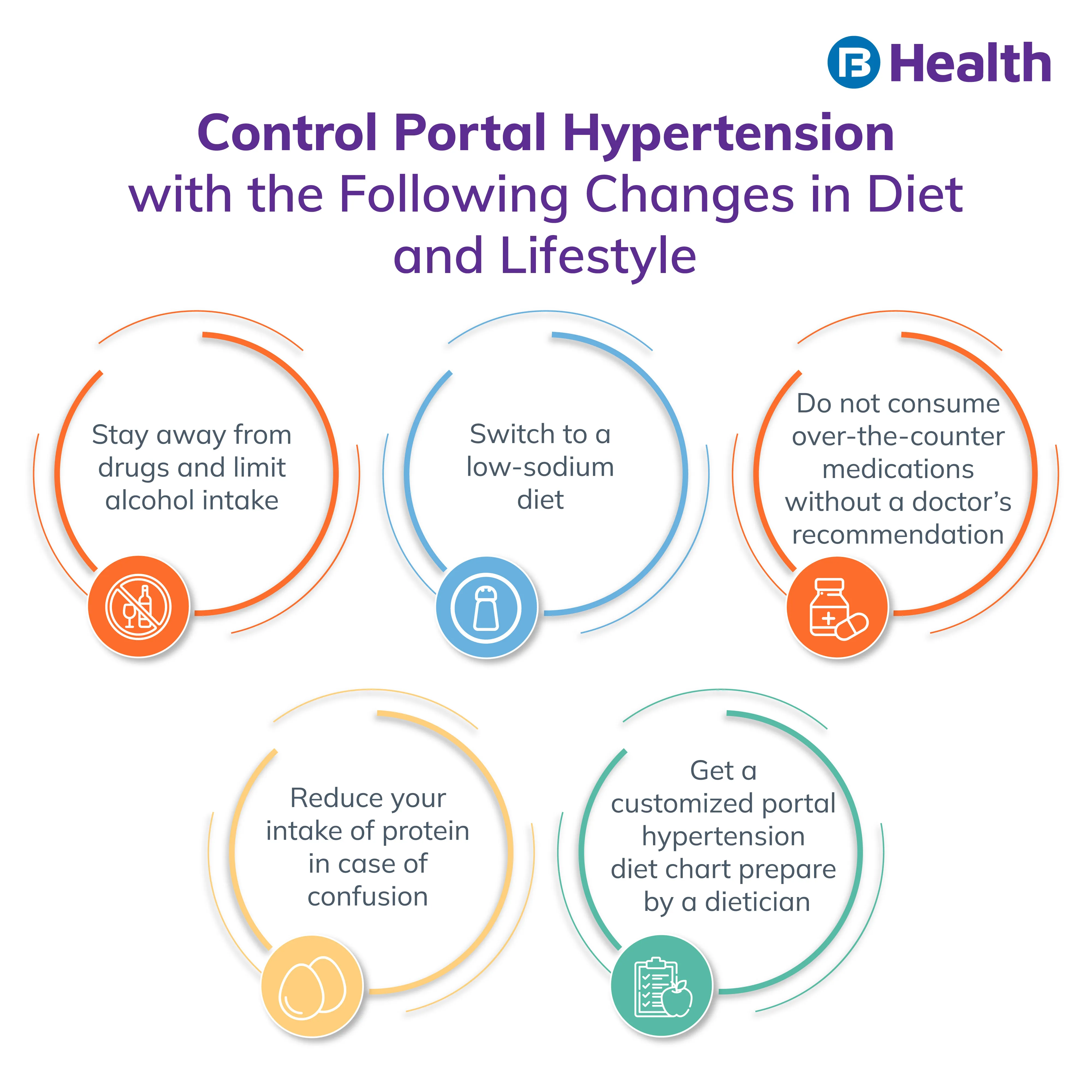Hypertension | 5 min read
What is Portal Hypertension: Causes, Symptoms and Treatment
Medically reviewed by
Table of Content
Synopsis
When it comes to portal hypertension, it is important to understand the link between cirrhosis of liver and portal hypertension symptoms. Find out all about portal hypertension treatment and more.
Key Takeaways
- Portal hypertension is caused by a spike of blood pressure in the portal vein
- Causes of portal hypertension include liver conditions such as cirrhosis
- Portal hypertension treatment is usually done in two levels
Portal hypertension is caused by a spike of blood pressure in your portal vein [1]. When your portal venous pressure gradient goes beyond five mmHg, it is likely that you have portal hypertension [2]. Note that the portal vein plays a key role by carrying blood to the liver from other digestive organs. A blockage hampering the blood flow in the liver leads to a spike in blood pressure, which is known as portal hypertension. This increase in blood pressure makes veins around the stomach and esophagus enlarged and fragile. Veins in this condition are called varices. Blood loss is possible due to this condition.
The function of the portal vein is different from the other veins in your body. While the rest of the veins carry blood from all your body parts to your heart, the portal vein carries blood from the pancreas, stomach, and other digestive organs to your liver. Any disruption in this process leads to portal hypertension. This can be harmful to your health unless treated in time. Read on to know the causes, symptoms, treatment portal hypertension, and more.
Causes of Portal Hypertension
The primary cause of portal hypertension is cirrhosis. This is when scars form on the liver and are caused by alcoholism or hepatitis. Other causes of cirrhosis, which are also causes of portal hypertension, are as follows:
- Primary biliary cholangitis
- Primary sclerosing cholangitis
- Autoimmune hepatitis
- Liver infections
- Cystic fibrosis
- A build-up of iron in your body
- Non-alcoholic fatty liver disease
- Thrombosis
- Reaction to certain medicines

Portal Hypertension Symptoms
Portal hypertension is a condition that is usually associated with cirrhosis. As such, there are no symptoms to identify the condition separately. However, certain complications may indicate portal hypertension, which are:
- Blood coming out with vomit and stools
- Gastrointestinal bleeding indicates injury and bleeding from varices, which can also become visible with darkened stools.
- Encephalopathy
- Disrupted liver function may cause you to experience forgetfulness and confusion.
- Low white blood cell count or decreased levels of platelets
- A build-up of fluid in your abdomen or ascites
Diagnosis of Portal Hypertension
Diagnosing portal hypertension may be difficult due to the subtle symptoms. However, doctors can recommend a few tests to diagnose in a conclusive manner. These are:
- Ultrasound scan
- CT scan
- Elastography
- Endoscopy
- Blood tests
Doctors can measure the blood pressure in your liver by inserting a catheter with a BP monitor attached.
Additional Read: Fatty Liver: How to Spot It
Portal Hypertension Treatment
Treatment for portal hypertension usually involves medication and lifestyle changes. Doctors may prescribe a portal hypertension diet and medications to manage the issues. Some cases may need radiological or endoscopic therapy or even surgeries. The first goal is to stabilize the bleeding and then treat the issue. Treatment is decided as per the seriousness of your symptoms and the condition of your liver. This treatment is thus divided into two levels.
First level:
In the first level of portal hypertension treatment, episodes of variceal bleeding get treated with medications or endoscopic therapies. Doctors also suggest following a portal hypertension diet and making other lifestyle changes to help your digestive system heal. Note that there are two types of endoscopic therapies:
- Banding
- In the case of banding, a gastroenterologist blocks the excess blood supply to the enlarged veins with the help of rubber bands.
- Sclerotherapy
- In sclerotherapy, doctors inject a solution into the bleeding varies to stop the loss of blood or reduce its risk.
Doctors may recommend taking medications along with endoscopic therapy to lower the blood pressure in your varices. To control the risk of continuous bleeding, you may have to take:
- Nitrates
- Beta-blockers
- Isosorbide
- Propranolol
Apart from these, doctors may also prescribe the drug lactulose in case you are experiencing confusion and other encephalopathy-related mental conditions. This drug also can boost the formation and movement of bowels.
Second level:
At times, the first level of portal hypertension treatment may not completely control the bleeding variance. You may need to undergo one of the following procedures to lower the pressure of blood in the varices:
- Transjugular intrahepatic portosystemic shunt (TIPS): It is a radiological procedure where doctors place a stent in the middle of your liver. The stent connects your portal veins with the blood vessels around having lower pressure of blood and thus helps channel the excess blood that accumulates in the varices
- Distal splenorenal shunt (DSRS): It is a surgical procedure to link the splenic vein with the left kidney vein. It also helps to lower the pressure in your ovaries and reduce bleeding.
However, remember that doctors may conduct the following procedures before you undergo TIPS and DSRS:
- A physical check-up
- Overall evaluation of your medical history
- Angiogram
- Endoscopy
- Ultrasound
- Blood tests
Remember, portal hypertension is different from what you know as hypertension. There are also other types of hypertension, such as renal hypertension. Apart from that, about 1% of people who have hypertension may get malignant hypertension, a condition that can be life-threatening. It is important to watch out for all of them. Make sure to get a doctor's consultation whenever you feel under the weather for a long. Now, with the fourth stage of the pandemic rising in India, remote consultation is a smart choice. A prudent choice for this can be the Bajaj Finserv Health platform.
Here you can avail of remote consultation by doctors across specialties in 17+ major Indian languages. Enjoy additional flexibility by selecting a doctor based on their experience, locality, and time of availability. With a network of 8,400+ doctors to provide you with healthcare support, you can stay healthy with ease.
References
- https://link.springer.com/chapter/10.1007/978-3-642-76802-6_11
- https://www.ncbi.nlm.nih.gov/books/NBK507718/
Disclaimer
Please note that this article is solely meant for informational purposes and Bajaj Finserv Health Limited (“BFHL”) does not shoulder any responsibility of the views/advice/information expressed/given by the writer/reviewer/originator. This article should not be considered as a substitute for any medical advice, diagnosis or treatment. Always consult with your trusted physician/qualified healthcare professional to evaluate your medical condition. The above article has been reviewed by a qualified doctor and BFHL is not responsible for any damages for any information or services provided by any third party.





